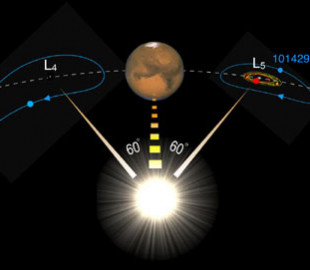
Astronomers have discovered another asteroid that shares an orbit with Mars. Such asteroids are called Trojans, and they orbit in two clusters, one in front and one behind planet. However, the origin of the Martian Trojans is unclear.
There are currently 14 known Martian Trojans, and the newest of them is called 2023 FW14. They are grouped into two groups, one of which is at 60 degrees ahead of Mars and another 60 degrees behind. These are Lagrange 4 and Lagrange 5 points.
Most Martian Trojans are at L5, and this newly discovered Trojan – the second found at L4.
This discovery is reported in a new study published in the journal Astronomy and Astrophysics. It is called ” Dynamics of 2023 FW14, the second Martian L4 Trojan, and its physical characterization using the 10.4m telescope Gran Telescopio Canarias “. The lead author is Raúl de la Fuente Marcos from the Department of Earth Physics and Astrophysics at Complutense University of Madrid.
Scientists aren't sure where the Martian Trojans came from. Other Trojans, such as the Jupiter Trojans, may have been captured by Jupiter in the early years of the Solar System. Or Jupiter captured them later when it migrated.
But Mars is a much less powerful planet, and astronomers aren't sure that Mars can host Trojans the way Jupiter does. Martian Trojans may be as old as Jupiter's Trojans, but some evidence suggests otherwise. A dozen or so more Trojans at L5 on Mars appear to be a family formed by a single collision. The family is called Eureka, and its spectra indicate an olivine-rich composition.
Olivine is relatively rare in the main asteroid belt. This has led some researchers to suggest that the L5 Martian Trojans are the remnants of an ancient collision between Mars, where olivine is widespread, and a planetoid.
The two L4 Martian Trojans differ from each other one. They do not have the same spectra as the L5 Trojans, but there is some similarity in their spectra, so the common origin of these two objects is quite possible.
In this work, the researchers set out to determine the origin of 2023 FW14. They used the Gran Telescopio Canarias telescope for their work. This is a 10.4-meter telescope on the Canary Islands in Spain with the OSIRIS camera spectrograph mounted on it.
< p>The spectrum of 2023 FW14 allows it to be classified as an Xc-type asteroid. The name X-type includes several different types of asteroids with similar spectra but probably different compositions. Xc-types are a subclass of X-types that occupy an intermediate position between C-type asteroids, the most common type of asteroid in the Solar System, and K-type asteroids, which are rare.
2023 FW14 has a higher orbital eccentricity and a smaller mode than the other Mars L4 Trojan.  ;This means that it occupies an unstable region and orbits at the whim of several different resonances. This instability means that in a few million years it will most likely be ejected.
According to the researchers' calculations, its size is approximately 318 meters (+493/-199), which makes it one of the smallest known Trojans to date.
As for its origin, according to the authors, there are two possibilities .
Its behavior suggests that it was captured from the population of near-Earth asteroids (NEA) crossing Mars. But it could also be a fragment of another trojan that has not yet been detected or is no longer a trojan .
Spectral data suggests otherwise. Both L4 asteroids appear more primitive than Mars L5 Trojans. The 2023 FW14 spectrum also supports the idea that it is a captured Mars NEA crossing. However , according to the authors, these data are not as clear-cut and cannot be used to exclude another hypothesis, according to which the asteroid formed in situ. “Despite its incompleteness, the data support the interpretation of 2023 FW14 as an interloper captured from the Mars NEA population, which intersect, but they cannot be used to reject the competing hypothesis that 2023 FW14 was formed in situ,” the authors write.

